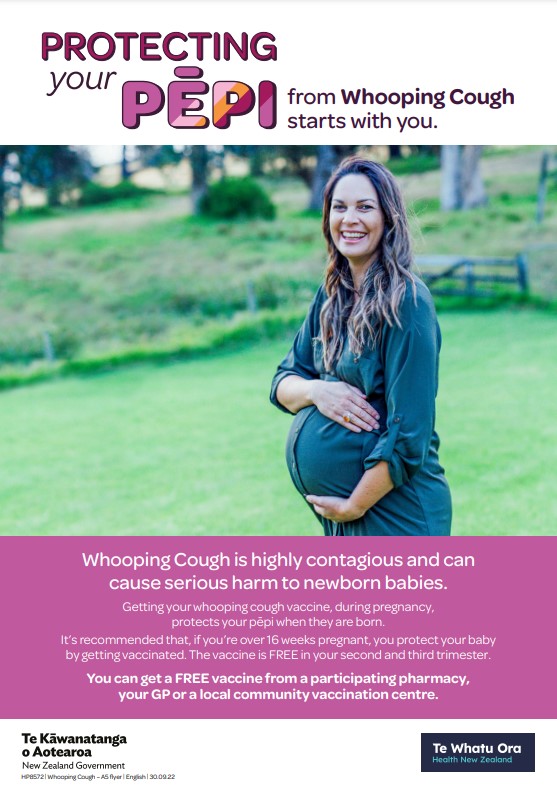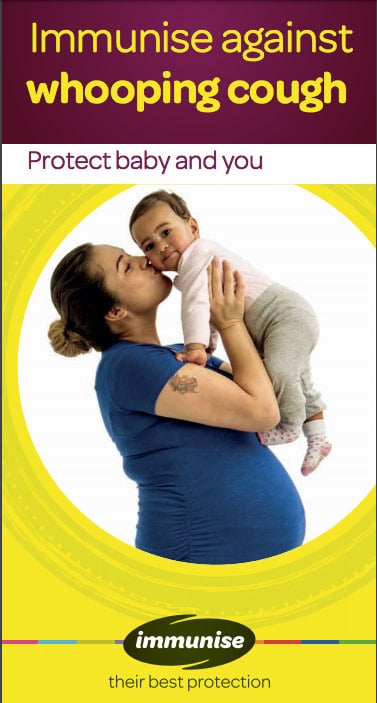Pertussis vaccine
Vaccination against whooping cough
Key points about pertussis vaccine
- The pertussis vaccine offers protection against the bacterial infection pertussis (whooping cough).
- Pertussis vaccine is also called Infanrix-hexa®, Infanrix-IPV®, Boostrix® and Adacel®
- Find out about the pertussis vaccines and possible side effects.

The pertussis vaccine offers protection against the bacterial infection pertussis (whooping cough). Whooping cough is an infectious disease that causes coughing and difficulty breathing. It can be very serious in young babies who can catch whooping cough from family/whānau members. Read more about whooping cough.
The pertussis vaccine works by causing your body to produce antibodies against the bacteria responsible for the pertussis infection and in this way protects against the disease.
To protect babies in your family, make sure you, your older children and extended family are up-to-date with vaccinations.
In Aotearoa New Zealand the pertussis vaccines used are Infanrix- hexa®, Infanrix-IPV®, Boostrix® and Adacel® .
You need whooping cough vaccinations throughout your life. In Aotearoa New Zealand, the pertussis vaccine for whooping cough is free for pregnant people, all children under 18 years old and adults from 45 and 65 years old.
Children and young people
In Aotearoa New Zealand vaccination is free for children and young people aged under 18 years. Babies and young children should get their vaccine doses on time at 6 weeks, 3 months and 5 months. Booster doses are then available at 4 and 11 years old. Read more about the Aotearoa New Zealand childhood immunisation schedule(external link).
If your child has missed getting their vaccine, that’s okay. Talk to your healthcare provider about catch up doses for people under 18 years.
Pregnant people
Immunising people who are pregnant protects babies in their first 6 weeks of life until they can receive their own immunisation.
- The vaccine is free during pregnancy and it's recommended to have it in the second trimester, but it can be given from 16 weeks of pregnancy until 2 weeks before birth.
- You should get a booster pertussis vaccine at each pregnancy because protection against pertussis decreases over time, even if your pregnancies are only a year or 2 apart.
- Read more about vaccinations and pregnancy.

Others
In adults, booster doses are given as a combination vaccine called Boostrix® or Adacel® which also protects against diphtheria and tetanus.
Free booster doses (Boostrix) are available for:
- adults 65 years of age and above unless they have already received a booster within the past 10 years
- adults 45 years of age and above who haven't previously had 4 doses of tetanus-containing vaccine.
The cost of the vaccine is free, but there may be a small charge for the injection to be given.
Note: The protection Boostrix® or Adacel® provides against whooping cough is expected to decrease 4 to 6 years after vaccination.
Some adults are recommended to have a whooping cough booster at least every 10 years, eg, if you live with a newborn baby. Parents or caregivers with babies in special care baby units may also be eligible for a free vaccine.
If you're at higher risk of becoming very unwell if you catch whooping cough (eg, if you have a chronic respiratory conditions, congenital heart disease or a weakened immune system) you should also get the vaccine.
If you’re not eligible for a free whooping cough booster, they can be purchased (Adacel). Your vaccinator can give you advice on how often it’s recommended you have a booster.
To reduce the number of shots needed, the pertussis vaccine is combined with other vaccines into a single injection. There are 3 funded pertussis-containing vaccines, each one has different ingredients and is used for different groups of people.
- Infanrix-hexa: Given to babies at 6 weeks, 3 months and 5 months of age,
- Infanrix-IPV: Given to children as a booster at 4 years of age
- Boostrix: Given to children as a booster at 11 years of age and to adults, including pregnant people. Boostrix is also used for catch-up doses for 10-18 year-olds if any doses have been missed.
- Adacel: a booster dose that isn't funded.
Immunity to pertussis develops within 10 to 14 days of receiving the vaccine. However, the effectiveness of the vaccine lessens with time and protection can be expected to last between 5 to 10 years in children.
If pertussis vaccination is given after you have already become infected with pertussis, the vaccination will be ineffective in preventing whooping cough.
The pertussis vaccine is combined with other vaccines so it also protects against other diseases such as tetanus and diphtheria. Read more about its use for diphtheria and tetanus.
How are these vaccines given?
These vaccines are usually given intramuscularly (injected into the muscle) to the upper arm for adults and older children or thigh for younger children.
Funded and unfunded pertussis vaccines can be given by your nurse, doctor, healthcare provider, and some pharmacies.
Find a provider near you by on the following this link to the Healthpoint website(external link) and entering your address.
- If you're eligible for a free vaccination, there won't be a cost for the pertussis vaccine, but there may be an administration fee.
- If you're not eligible to get a free vaccination, you will need to pay.
- Pharmacists who are trained as vaccinators can administer the pertussis booster vaccine, Boostrix to people aged 18 years and over, or 13 years and over if pregnant.
- A small number of pharmacists who have done extended training can administer any vaccination on the National Immunisaton Schedule(external link), including those for babies. Always call your pharmacy ahead of time to find out if they offer this service, the cost and whether you need to make an appointment.
Vaccines on the National Immunisation Schedule(external link) are free. Other vaccines are only funded for people who are at particular risk of disease. You can choose to pay for vaccines that you're not eligible to receive for free.
Like all medicines, vaccines can cause side effects, although not everyone gets them.
| Side effects | What should I do? |
|---|---|
|
|
|
Babies and children
|
|
|
Read more about medicines and side effects and reporting a reaction you think might be a side effect.
The following links have more information on pertussis-containing vaccines:
- The New Zealand National Immunisation Schedule(external link)
- Tips following immunisation(external link) Health New Zealand | Te Whatu Ora
Medsafe Consumer Information
References
- Pertussis(external link) The Immunisation Advisory Centre, NZ
- Adacel(external link) The Immunisation Advisory Centre, NZ
- Boostrix(external link) The Immunisation Advisory Centre, NZ
- Infanrix-hexa(external link) The Immunisation Advisory Centre, NZ
- Infanrix-IPV(external link) The Immunisation Advisory Centre, NZ
Brochures

Health Ed, NZ, 2020
Chinese Simplified, Chinese Traditional, Hindi, Te reo Māori, Sāmoan, Tongan
Medicines and side effects
Healthify He Puna Waiora, NZ, 2024

Health Quality and Safety Commission, NZ, 2019 English, te reo Māori
Credits: Sandra Ponen, Pharmacist, Healthify He Puna Waiora. Healthify is brought to you by Health Navigator Charitable Trust.
Reviewed by: Angela Lambie, Pharmacist, Auckland
Last reviewed:
Page last updated:





